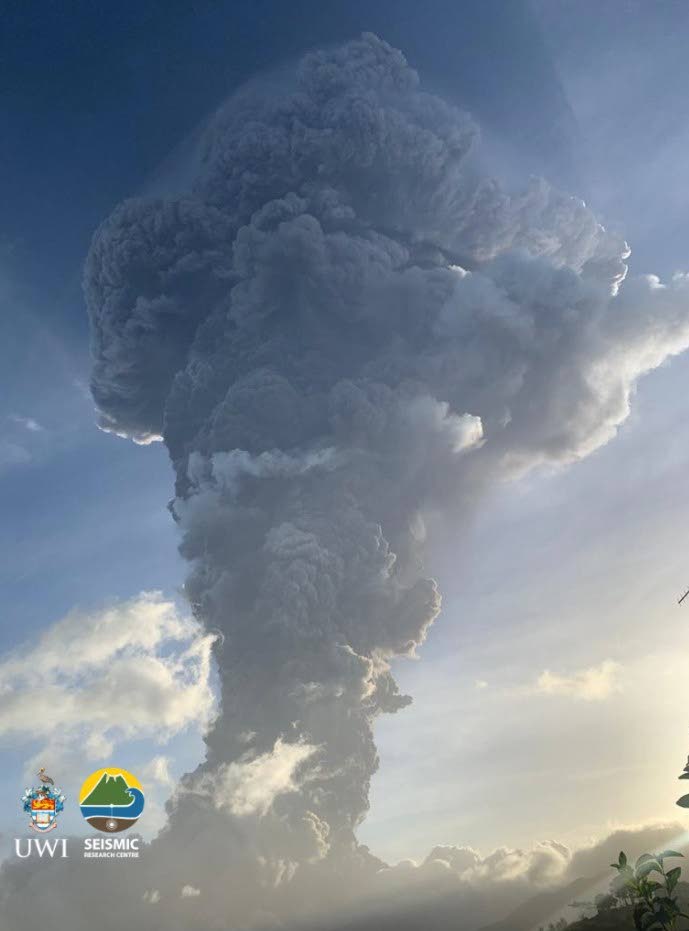All about volcanoes

DR FAITH B.YISRAEL
Imani.Consulting.Tobago@gmail.com
The last week has been very difficult for our Caribbean brothers and sisters, particularly in St Vincent and the Grenadines, but also for other neighbouring countries. We all looked in horror as the La Soufriere or Soufriere Saint Vincent volcano started erupting.
Obviously this isn’t the first volcano in the world to have activity, but it is certainly the closest one that I can remember in my adult life. This occurrence made me realise that I didn’t know much about volcanos. In this article, I am sharing what I’ve learned thus far.
What are volcanoes?
The UWI Seismic Research Centre says volcanoes are “vents or openings in the earth's crust through which, hot, molten rock (called magma) and gases from the interior of the earth are released. Sometimes, but not always, the solid parts pile up around the vent to form a volcanic mountain. Some volcanoes are literally slits or holes in the ground while others are broad mountains with gentle slopes.”
What is in volcanic ash?
The National Geographic states, “Volcanic ash is a mixture of rock, mineral and glass particles expelled from a volcano during a volcanic eruption. The particles are very small—less than two millimeters in diameter. They tend to be pitted and full of holes, which gives them a low density. Along with water vapour and other hot gases, volcanic ash is part of the dark ash column that rises above a volcano when it erupts.
“Due to their tiny size and low density, the particles that make up volcanic ash can travel long distances, carried by winds. When an ash column is moved about by wind, it is called an ash plume. Eventually the ash in the sky falls to the ground. It may create a thick layer of dust-like material on surfaces for miles around the original eruption.
“Unlike the ash produced by burning wood and other organic materials, volcanic ash can be dangerous. Its particles are very hard and usually have jagged edges. As a result, it can cause eye, nose, and lung irritation, as well as breathing problems. While in the air, ash can cause problems for jet engines, forcing airlines to cancel flights through the affected area. An ashfall that leaves a thick layer of ash may cause roofs to collapse, clog gutters, and interfere with air conditioning units. Animals in an area coated by volcanic ash may have difficulty finding food, as the plants in the region may be covered in ash. Ash can also contaminate water supplies.”
Where are the “live” volcanos in the Eastern Caribbean?
The earth's crust is made up of slabs of material called plates which move relative to each other. The Eastern Caribbean islands lie on a plate boundary. The North American plate, which is the denser of the two, sinks beneath the Caribbean plate creating suitable conditions for magma to be produced. The magma then rises to the surface of the earth where it may erupt to form a volcano. This process is called subduction and this is how the volcanic islands of the Eastern Caribbean were formed.
“There are 19 ‘live’ (likely to erupt again) volcanoes in the Eastern Caribbean. Every island from Grenada to Saba is subject to the direct threat of volcanic eruptions. Islands such as Grenada, St Vincent, St Lucia, Martinique, Dominica, Guadeloupe, Montserrat, Nevis, St Kitts, St Eustatius and Saba have 'live' volcanic centres, while other islands such as Anguilla, Antigua, Barbuda, Barbados, British Virgin Islands, most of the Grenadines and Trinidad and Tobago (which are not volcanic) are close to volcanic islands and are, therefore, subject to volcanic hazards such as severe ash fall and volcanically-generated tsunamis.”
Volcanic hazards
Volcanic eruptions can have a drastic impact on our lives. They can affect the property we own, the land we live on, the water we drink and even the air we breathe. Following are some of the hazards associated with volcanoes:
· Pyroclastic flows:
These hot, fast-moving mixtures of ash, rock fragments and gas flow from a collapsed eruption column or lava dome, travel down valleys and cause total devastation of the area over which they flow. Pyroclastic flows have been the main cause of destruction and loss of life in Montserrat since the onset of the Soufriere Hills volcano eruption in 1995. They differ from pyroclastic surges in that they are more dense and usually travel with a greater physical force, whereas surges usually contain more gases.
· Pyroclastic surges:
This turbulent cloud of gases and rock debris moves above the ground surface at great speeds. Pyroclastic surges form in a similar way to pyroclastic flows, but their effects are more widespread since they may also sweep across ridges and hills as well as down valleys. A hot pyroclastic surge can cause death from suffocation, inhalation of poisonous gases and severe burns. Pyroclastic surges from Mt Pele completely destroyed the town of St Pierre in Martinique in 1902, killing about 30,000 people.
· Ballistic projectiles:
Ballistic projectiles are rocks that an erupting volcano may hurl into the air. These blocks and bombs travel like cannonballs and usually land within two kilometers of the vent (but can travel as far as five kilometers, or even further, if the eruption is very explosive.)
· Lava flows:
These consist of molten rock that stream down the slope of a volcano, destroying everything in its path and possibly causing forest fires (as is typical of Hawaiian volcanoes). However, lava in the Eastern Caribbean is very viscous and does not flow very far from the vent. Rather, as the volcano emits lava it accumulates around the vent thereby creating a lava dome. These lava domes are often unstable and eventually they collapse and lead to pyroclastic flows.
· Ash falls:
Large quantities of ash produced during a volcanic eruption can be thick enough to collapse roofs, destroy vegetation and cause aircraft, ship and car engines to malfunction. They can also be very dangerous to people's health since even the finest fractions of ash may cause serious respiratory problems if they are inhaled. This hazard may persist long after the eruption itself has ended and can affect neighbouring islands as well.
· Lahars (mudflows):
These are mixtures of volcanic water and rock fragments which rush down the slopes of a volcano and into the surrounding valleys. The word lahar is an Indonesian term that describes a mudflow often triggered by heavy rains or earthquakes during and after a volcanic eruption. Lahars are destructive to everything in their path and may occur years after an eruption has ended.
· Volcanic gases:
Gases such as sulphur dioxide (SO2) and hydrogen sulphide (H2S) are present in toxic amounts close to the vent of an erupting volcano and may be present close to hot springs around any live volcano.
Further away from the vent they can become dissolved in atmospheric clouds to produce acid rain and mist which affect human and animal eyes and respiratory systems and corrode metal building materials. One of the most common volcanic gases, carbon dioxide (CO2), is not poisonous but nevertheless, it is extremely dangerous. It is heavier than air and tends to accumulate in hollows in the ground, displacing the breathable air. Since it is invisible and has no taste or smell, people and animals are unable to notice that it is there and may suffocate. People have died in this way at the boiling lake in the Valley of Desolation in Dominica.
· Lateral blasts:
Lateral blasts are horizontally-directed clouds of gases and extremely hot rock particles that explode outwards at very high speeds from the volcano. They can develop without warning during any explosive eruption and can destroy everything for miles within a fan-shaped area on the blast side of the volcano. Since they carry rock debris at high speeds, lateral blasts can devastate areas of tens to hundreds of square kilometers within a few minutes, and can destroy manmade structures and kill all living things by abrasion, impact, burial, and heat.
· Debris avalanches:
Debris avalanches are moving masses of rock and soil that occur when the flank of a mountain or volcano collapses and slides downslope. As the moving debris rushes down a volcano and into river valleys, it incorporates water, trees, bridges, buildings, and anything else in the way. Debris avalanches may travel several kilometers before coming to rest, or they may transform into more water-rich lahars, which travel many tens of kilometers downstream.
· Lightning strikes:
Lightning strikes may occur during volcanic eruptions as a result of friction between ash, rock fragments, steam and gases in the eruption cloud. Lightning strikes were a significant cause of death during the eruption of the Soufriere of St Vincent in 1902 and caused considerable property damage during the 1979 eruption.
Dr. Faith B.Yisrael (formerly Faith Brebnor) is a health educator, social scientist, public health specialist and politician.
Email address: Imani.Consulting.Tobago@gmail.com
Phone number: 494-8827
Facebook Page: @ImaniConsultingAndFoundationTobago
REFERENCES:
University of the West Indies – Seismic Research Centre, “Volcanos”: http://uwiseismic.com/General.aspx?id=46
National Geographic, “Volcanic Ash”: https://www.nationalgeographic.org/encyclopedia/volcanic-ash/



Comments
"All about volcanoes"